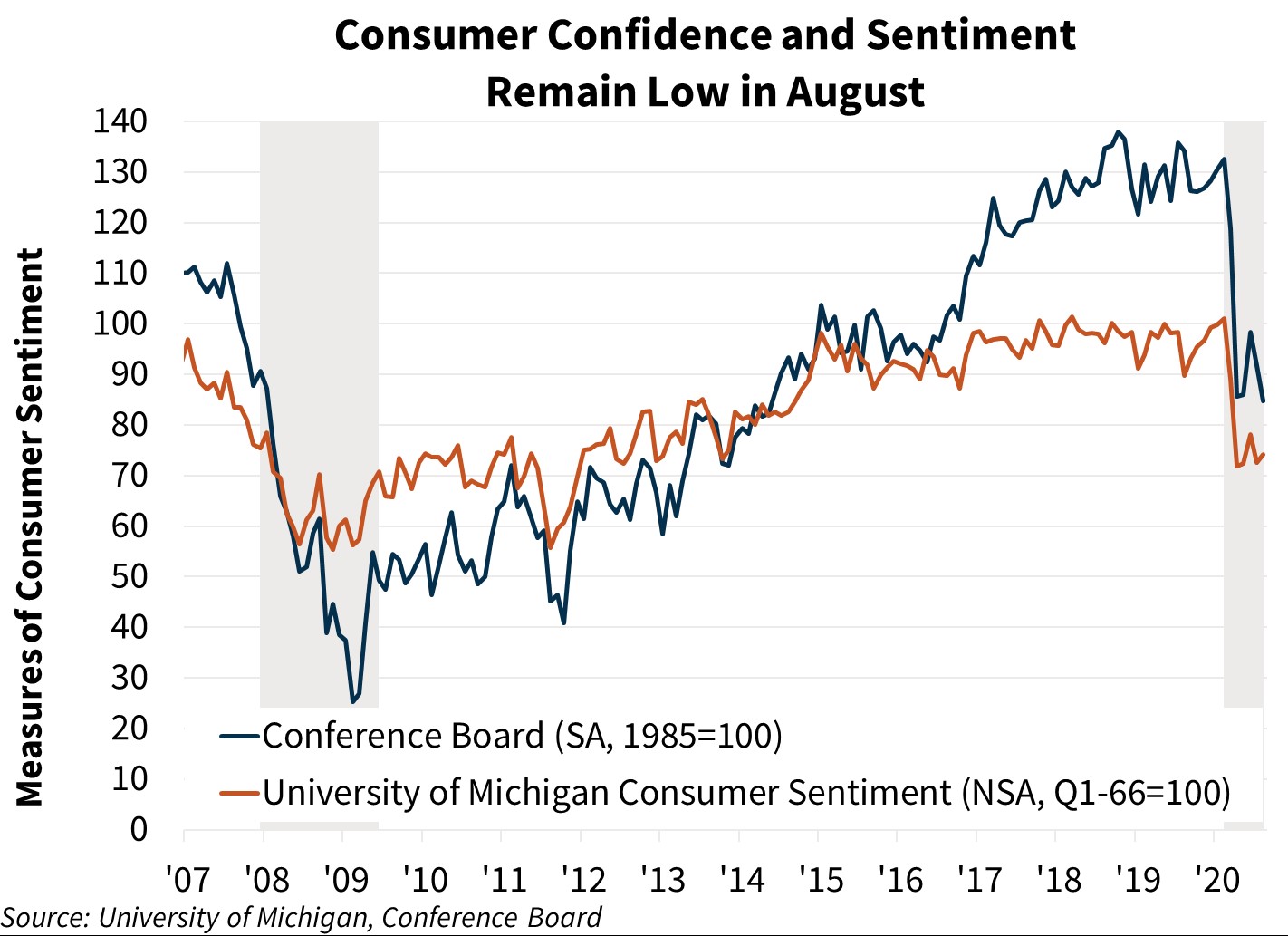Despite Soft Consumer Sentiment, Housing Data Continues to Surprise to the Upside
Key Takeaways:
- Gross domestic product, adjusted for inflation, fell 31.7 percent annualized in Q2 2020, according to the second estimate from the Bureau of Economic Analysis, slightly better than the advance estimate of a decline of 32.9 percent annualized. Upward revisions were made to private inventories, consumer spending, business fixed investment, and exports. Pre-tax corporate profits fell 11.1 percent from the prior quarter (not annualized), following a decline of around 12 percent in the first quarter.
- Personal income, adjusted for inflation, was essentially unchanged in July, according to the Bureau of Economic Analysis. Excluding transfer payments, real personal income grew 0.7 percent. Real personal consumption expenditures rose 1.6 percent, though remains 4.7 percent below the level seen in February. The personal saving rate fell from 19.2 percent to 17.8 percent. From a year ago, the PCE price index rose 1.0 percent, an acceleration of one-tenths from June, while the core PCE price index rose 1.3 percent, an acceleration of two-tenths from last month.
- The Conference Board Consumer Confidence Index fell 6.9 points in August to 84.8, the lowest reading since May 2014. The present situation index pulled back after rising for two months, while the index for consumer expectations continues to decline. The University of Michigan Consumer Sentiment Index edged up in the final August reading, rising 1.6 points to 74.1. The consumer expectations index improved, while the current economic conditions index edged up slightly. According to the press release, “while nine-in-ten consumers viewed the current state of the economy negatively in August, half of all consumers anticipated the economy would improve in the year ahead.”
- Durable goods orders increased 11.2 percent in July, according to the Census Bureau, though remained 6.3 percent below the level seen in February. The increase in new orders was driven by a 35.6 percent increase in new orders for transportation equipment. Excluding transportation, new orders rose 2.4 percent. Total shipments rose 7.3 percent. Orders for core capital goods (nondefense excluding aircraft) rose 1.9 percent while core shipments increased 2.4 percent.
- New single-family home sales jumped 13.9 percent in July to a seasonally adjusted annualized rate (SAAR) of 901,000, the highest level since December 2006, according to the Census Bureau. This increase was in part driven by an increase in sales of homes that have not yet been started, which rose to the highest level since the end of 2006. Sales rose in every region except for the Northeast. From a year ago, new home sales rose 41.8 percent, the fastest annual increase since February 1996. Year-to-date sales are now up 8.4 percent from the same period in 2019. The inventory of new homes for sale continued to decline, falling to the lowest level since May 2018, while the months’ supply fell six-tenths to 4.0, tying the lowest level since 2004. From a year ago, the median sale price rose 7.2 percent.
- The National Association of REALTORS® Pending Home Sales Index, which records contract signings of existing homes and typically leads closings by one to two months, increased 5.9 percent in July to 122.1. Sales rose in every region. From a year ago, pending sales rose 15.5 percent.
Forecast Impact:
Economic data in July continue to support our expectations for strong quarterly growth for the third quarter. The July increase in personal consumption showed a slowing from June but was in line with our expectations. Due to a low first quarter base level, the report is consistent with a strong rebound in the third quarter on a quarterly basis. Coupled with a continually elevated savings rate, incomes should provide ample support for consumer spending and growth in the coming months. However, risks to consumer spending remain given the softening consumer sentiment seen in August and the recent expiration of supplemental $600-per-week unemployment benefits. The strength in orders for durable goods supports our expectation of an increase in business fixed investment in the third quarter, though may warrant a strengthening in our outlook. In housing, July data continued to show surprising resilience, with both new home sales and pending sales surpassing expectations. Low mortgage rates, pent-up demand, and what appears to be an increase in homebuyers moving to suburban areas in at least some metro areas is fueling a V-shaped housing recovery. While we expect new home sales and construction to continue to be a bright spot as the economy expands, we still expect the pace of sales to cool somewhat in coming months as pent-up demand diminishes. However, in light of this week’s reports, it is likely that we will be revising upwards our near-term forecast for home sales and construction.


Economic and Strategic Research Group
August 28, 2020
Opinions, analyses, estimates, forecasts and other views of Fannie Mae's Economic and Strategic Research (ESR) Group included in these materials should not be construed as indicating Fannie Mae's business prospects or expected results, are based on a number of assumptions, and are subject to change without notice. How this information affects Fannie Mae will depend on many factors. Although the ESR group bases its opinions, analyses, estimates, forecasts and other views on information it considers reliable, it does not guarantee that the information provided in these materials is accurate, current or suitable for any particular purpose. Changes in the assumptions or the information underlying these views, including assumptions about the duration and magnitude of shutdowns and social distancing, could produce materially different results. The analyses, opinions, estimates, forecasts and other views published by the ESR group represent the views of that group as of the date indicated and do not necessarily represent the views of Fannie Mae or its management.
